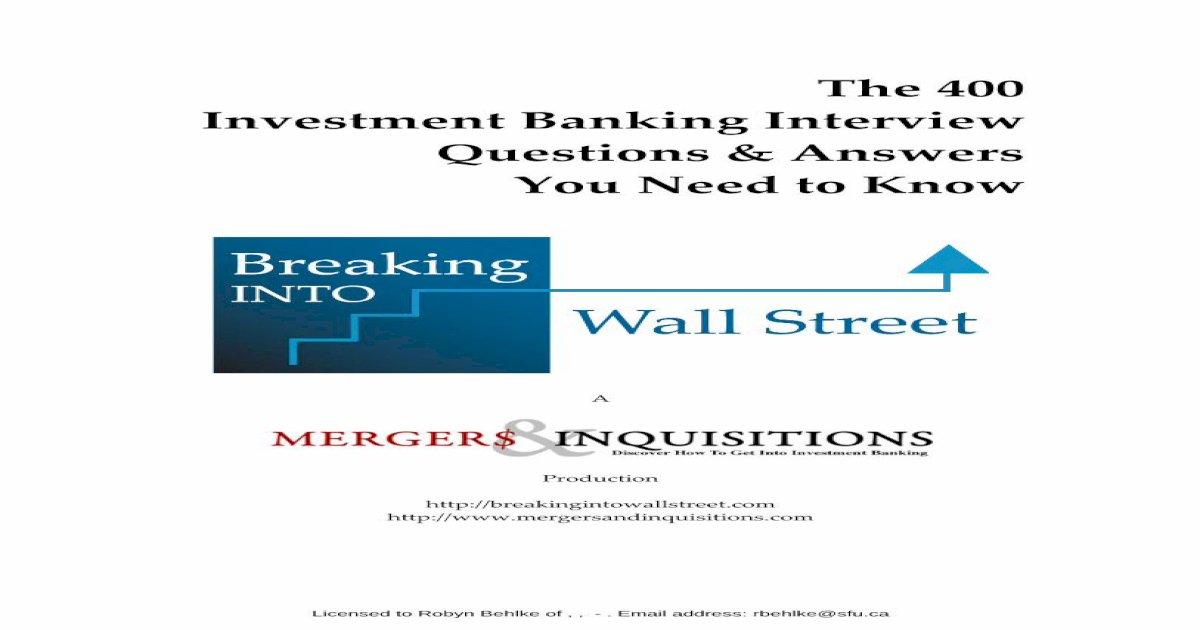Investment Banking Technical Interview Questions
See a Problem? We’d love your help. Let us know what’s wrong with this preview of The 400 Investment Banking Questions & Answers You Need to Know by Breaking Into Wall Street. Problem: Details (if other):
Thanks for telling us about the problem.
Table Of Contents:
Let’s start with this summary infographic (scroll down to go straight to a more detailed analysis):
First, note that this article is about investment banking interview questions – not the overall process, how to win interviews, or what to do before and after the interviews.
Second, I’m going to link and refer back to our existing coverage for many of these questions since the most important ones have dedicated articles on this site.
There are only four types of questions you’ll encounter in interviews at investment banks, and you can prepare for 3 / 4 of them in 1-2 days (or less).
The last category – technical questions – will take more time and effort, but you can save time by focusing on the right topics and ignoring the fluff.
Investment Banking Interview Questions Category 3: Discussing Deals, Markets, and Companies
This category includes questions such as:
These questions are not that important unless you’ve had extensive deal experience that the interviewers plan to dig into – but they do require extra research and preparation.
We recommend the following steps:
There are many tips on how to research and prepare for these questions in our articles on discussing a recent deal and discussing your own deals.
Example “Finance” Questions in Investment Banking Interviews
“Finance” means concepts such as the Time Value of Money, the Discount Rate, Present Value, and the Internal Rate of Return (IRR).
QUESTION: “How much would you pay for a company that generates $100 of cash flow every single year into eternity?”
ANSWER: It depends on your Discount Rate, or “targeted yield.”
If your Discount Rate is 10%, meaning you could earn 10% per year in companies with similar risk/potential return profiles, you would pay $100 / 10% = $1,000.
But if your Discount Rate is 20%, you would pay $100 / 20% = $500.
QUESTION: “A company generates $200 of cash flow next year, and its cash flow is expected to grow at 4% per year for the long term.
You could earn 10% per year by investing in other, similar companies. How much would you pay for this company?”
ANSWER: Company Value = Cash Flow / (Discount Rate – Cash Flow Growth Rate), where Cash Flow Growth Rate < Discount Rate.
So, this one becomes: $200 / (10% – 4%) = $3,333.
QUESTION: “What might cause a company’s Present Value (PV) to increase or decrease?”
ANSWER: A company’s PV might increase if its expected future cash flows increase, its expected future cash flows start to grow at a faster rate, or the Discount Rate decreases (e.g., because the expected returns of similar companies decrease).
The PV might decrease if the opposite happens.
QUESTION: “What does the internal rate of return (IRR) mean?”
ANSWER: The IRR is the Discount Rate at which the Net Present Value of an investment, i.e., Present Value of Cash Flows – Upfront Price, equals 0.
You can also think of it as the “effective compounded interest rate on an investment” – so, if you invest $1,000 today, end up with $2,000 in 5 years, and contribute and earn nothing in between, the IRR is the interest rate you’d have to earn on that $1,000, compounded each year, to reach $2,000 in 5 years.

